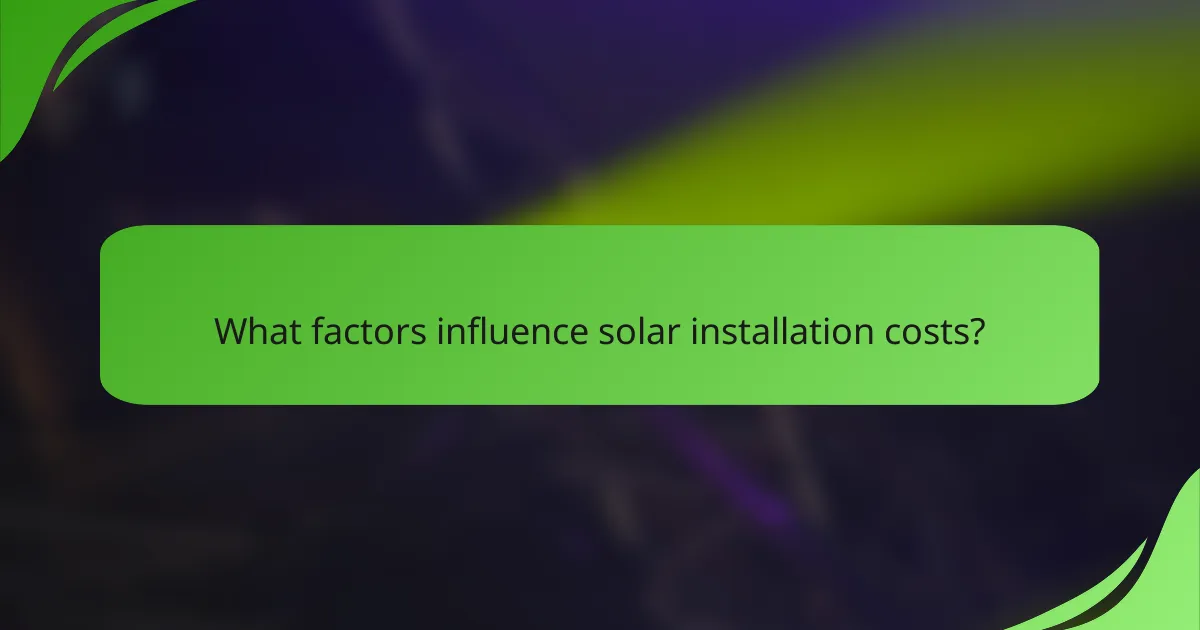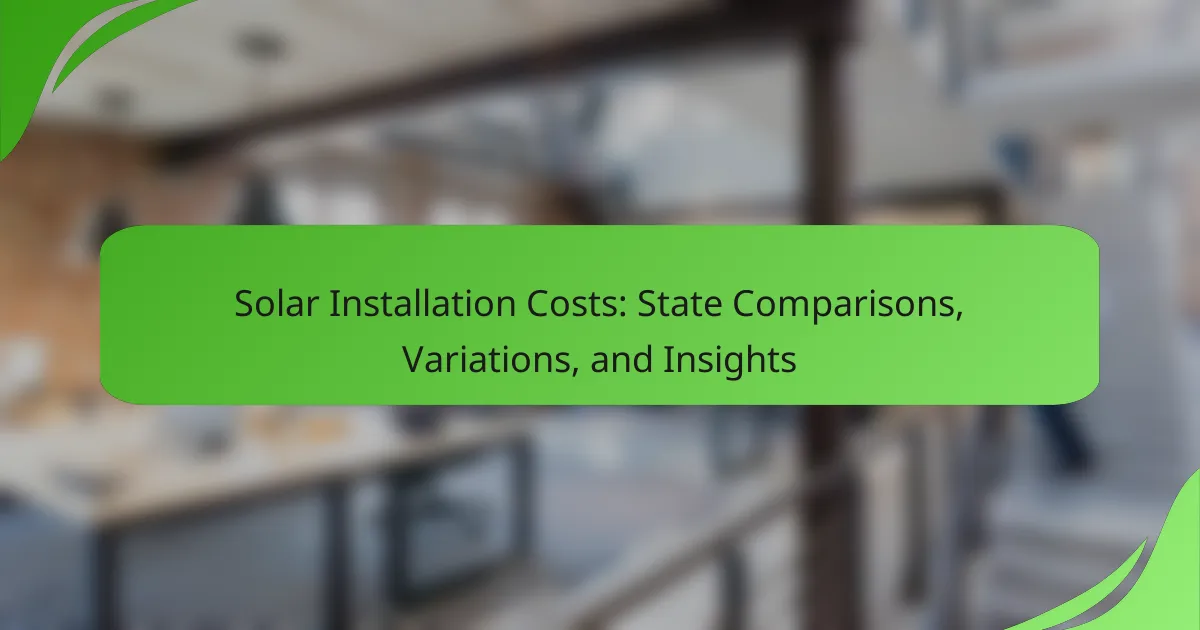Understanding solar installation costs is essential for homeowners considering a transition to renewable energy. These costs can vary significantly from state to state, influenced by factors such as system size, equipment quality, local incentives, and installation complexity. For instance, California typically sees residential installations ranging from $15,000 to $25,000, while Texas offers more affordable options at $2.50 to $3.50 per watt. By examining these variations, homeowners can better navigate their solar investment decisions.

What are the average solar installation costs in California?
The average solar installation costs in California typically range from $15,000 to $25,000 for a residential system, depending on various factors such as system size and equipment quality. These costs can vary significantly based on location, incentives, and specific installation requirements.
Average cost per watt
In California, the average cost per watt for solar installation is generally between $3.00 and $5.00. This price can fluctuate based on the type of solar panels chosen, installation complexity, and the overall size of the system. Homeowners should consider these factors when budgeting for solar energy solutions.
Cost variations by region
Solar installation costs can vary widely across different regions in California. For instance, urban areas like San Francisco and Los Angeles may see higher costs due to increased demand and labor rates, while rural areas might offer lower prices. It’s essential to compare quotes from local installers to find the best deal.
Incentives and rebates available
California offers several incentives and rebates to help offset solar installation costs. The federal solar tax credit allows homeowners to deduct a significant percentage of their installation costs from their federal taxes. Additionally, local programs and utility incentives may provide further financial assistance, making solar energy more accessible.

How do solar installation costs compare in Texas?
Solar installation costs in Texas generally range from $2.50 to $3.50 per watt, making it one of the more affordable states for solar energy. Factors such as local incentives, system size, and installation complexity can affect the final price.
Average cost per watt
The average cost per watt for solar installations in Texas typically falls between $2.50 and $3.50. This pricing can vary based on the quality of the solar panels, the inverter used, and the overall system design. Homeowners should consider obtaining multiple quotes to ensure they receive competitive pricing.
Cost variations by city
Cost variations for solar installations can be significant across different cities in Texas. For instance, urban areas like Houston and Dallas may have higher installation costs due to increased demand and labor rates, while rural areas might see lower prices. It’s advisable to research local installers and compare their offerings to find the best deal.
State incentives and tax credits
Texas offers several incentives and tax credits that can help reduce solar installation costs. The federal solar tax credit allows homeowners to deduct a percentage of their installation costs from their federal taxes. Additionally, some local utility companies provide rebates or performance-based incentives, which can further lower the overall expense. Homeowners should check with local authorities and utility providers to maximize their savings.

What factors influence solar installation costs?
Solar installation costs are influenced by several key factors, including system size and type, roof condition and orientation, and local labor rates. Understanding these elements can help homeowners estimate expenses and make informed decisions about their solar investments.
System size and type
The size and type of the solar system significantly impact installation costs. Larger systems generally cost more upfront but can offer better long-term savings on energy bills. For example, a typical residential solar system may range from 5 kW to 10 kW, with costs varying from around $15,000 to $30,000 before incentives.
Additionally, the type of solar technology used—such as monocrystalline, polycrystalline, or thin-film—can affect pricing. Monocrystalline panels tend to be more efficient but also more expensive, while polycrystalline panels are often more budget-friendly.
Roof condition and orientation
The condition and orientation of your roof play crucial roles in determining installation costs. A roof in good condition that faces south or southwest is ideal for solar panels, maximizing energy production. If repairs are needed before installation, this can add to overall costs.
Additionally, roofs with complex structures or shading from nearby trees may require more labor and specialized mounting systems, further increasing expenses. Homeowners should assess their roof’s suitability before proceeding with solar installation.
Local labor rates
Labor rates vary significantly by region and can greatly influence the total cost of solar installation. In areas with a high demand for solar energy, labor costs may be higher due to increased competition for skilled workers. Conversely, regions with lower demand may offer more competitive pricing.
It’s beneficial for homeowners to obtain multiple quotes from local installers to compare labor costs and services. Understanding local market conditions can help in negotiating better rates and ensuring a fair price for installation.

What financing options are available for solar installations?
Several financing options exist for solar installations, allowing homeowners and businesses to choose a method that fits their financial situation. These options include solar loans, leasing arrangements, and power purchase agreements, each with its own benefits and considerations.
Solar loans
Solar loans allow you to borrow money to purchase a solar system, which you then own outright. This option typically requires a down payment and offers fixed or variable interest rates, with repayment terms ranging from five to twenty years. Owning the system means you can take advantage of tax credits and incentives, potentially saving thousands over time.
When considering a solar loan, evaluate your credit score and shop around for the best interest rates. Some lenders may offer specialized solar financing with lower rates or flexible terms, making it easier to manage monthly payments.
Leasing options
Leasing options involve paying a monthly fee to use a solar system installed on your property without owning it. This arrangement often requires little to no upfront cost, making it accessible for those who may not have the funds for a full purchase. However, you typically won’t receive the tax benefits associated with ownership.
Leases can vary in length, usually from 15 to 25 years, and may include maintenance and monitoring services. It’s essential to read the terms carefully, as some leases may have escalators that increase your payments over time.
Power purchase agreements
Power purchase agreements (PPAs) are contracts where you agree to buy the electricity generated by a solar system at a predetermined rate. This option allows you to benefit from solar energy without the upfront costs of purchasing a system. The rate is often lower than your local utility’s rates, providing immediate savings on your electricity bills.
PPAs typically last between 15 and 25 years, and the solar provider usually handles installation and maintenance. Be aware of potential increases in rates over time and ensure the agreement aligns with your energy needs and budget.

How can homeowners reduce solar installation costs?
Homeowners can significantly lower solar installation costs by taking advantage of available financial incentives, selecting qualified installers, and making informed decisions about their solar systems. Understanding these options can lead to substantial savings and a more efficient installation process.
Utilizing federal tax credits
Federal tax credits can provide a substantial reduction in the overall cost of solar installations. Homeowners can claim a tax credit for a percentage of the installation costs, which can amount to thousands of dollars, depending on the system’s price. For instance, the federal solar tax credit is currently set at 30% for systems installed by the end of 2032.
To maximize benefits, ensure that your installation meets the necessary criteria and keep all documentation organized for tax filing. Consulting a tax professional can help clarify eligibility and optimize your savings.
Applying for state rebates
Many states offer rebates to incentivize solar energy adoption, which can further reduce installation costs. These rebates vary widely by state, with some offering fixed amounts per watt installed or a percentage of the system cost. For example, states like California and New York have robust rebate programs that can significantly lower upfront expenses.
To take advantage of these rebates, research your state’s specific programs and application processes. Be mindful of deadlines and requirements to ensure you receive the financial support available.
Choosing the right installer
Selecting a reputable solar installer is crucial for minimizing costs and ensuring quality work. Compare multiple installers based on their experience, customer reviews, and warranties offered. A well-reviewed installer may charge slightly more but can save you money in the long run through efficient installation and fewer maintenance issues.
Request detailed quotes from different companies, and don’t hesitate to ask about financing options. Avoid choosing the lowest bid without considering the quality of materials and workmanship, as this can lead to higher costs down the line. Aim for a balance between cost and quality to achieve the best value for your investment.

What are the long-term savings from solar installations?
Long-term savings from solar installations can be significant, often leading to reduced electricity bills and potential tax incentives. Homeowners may save tens of thousands of dollars over the lifespan of a solar system, typically around 25 years.
Initial Costs and Financing Options
The initial costs of solar installations can vary widely based on system size, location, and installation complexity. Homeowners should expect to pay anywhere from $15,000 to $30,000 before incentives. Financing options such as solar loans, leases, or power purchase agreements (PPAs) can help spread these costs over time.
Tax Incentives and Rebates
Many states offer tax incentives and rebates that can significantly reduce the upfront cost of solar installations. For example, the federal solar tax credit allows homeowners to deduct a percentage of the installation cost from their federal taxes. Additionally, local programs may provide cash rebates or performance-based incentives.
Electricity Bill Savings
Solar installations can lead to substantial savings on electricity bills. Depending on energy consumption and local electricity rates, homeowners might save anywhere from 50% to 100% on their monthly bills. These savings accumulate over the years, contributing to the overall return on investment.
Return on Investment (ROI) and Payback Period
The return on investment for solar installations typically ranges from 10% to 20% annually, depending on various factors including installation costs and energy savings. The payback period, or the time it takes for savings to equal the initial investment, usually falls between 5 to 10 years.
Long-term Maintenance Costs
While solar systems generally require minimal maintenance, homeowners should budget for occasional costs such as inverter replacements or panel cleaning. These costs are typically low compared to the savings generated, making solar a financially sound long-term investment.
